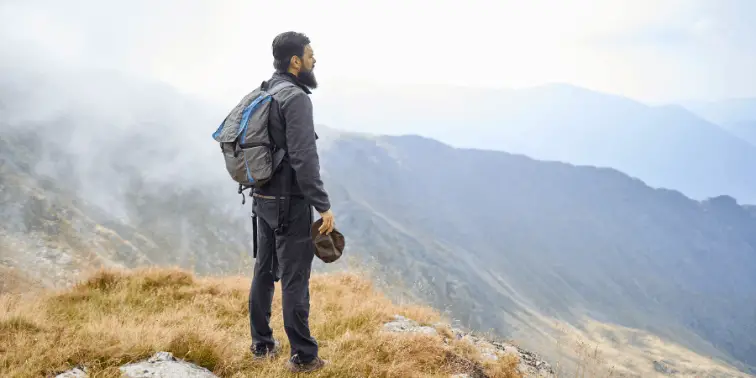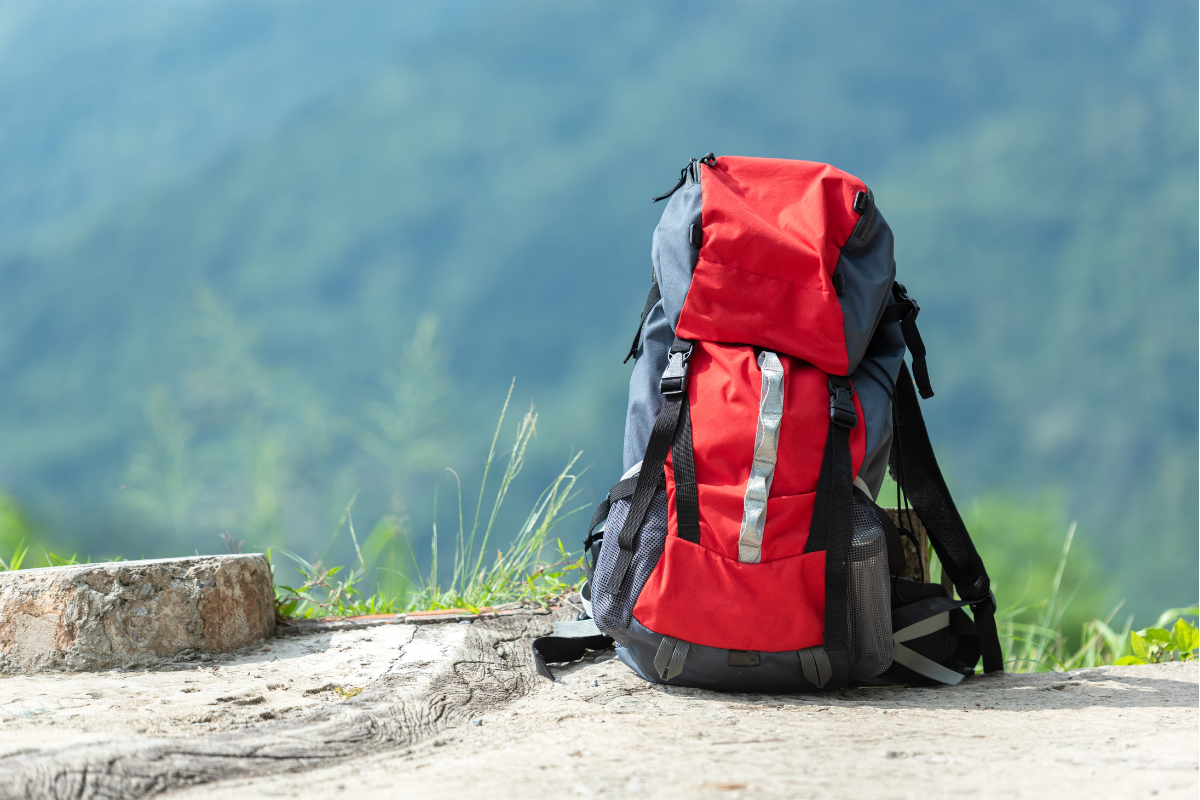It’s no surprise that the lighter your backpack is, the easier it will be for you while out on the trail. What may surprise you though is who should be carrying the bulk of the load.
According to findings by Kansas State University Physics Professor Michael O’Shea, while a hiker’s strength increases with weight, the hiker’s weight increase itself takes up a larger chunk of the carrying capacity for that hiker.
This runs opposite to conventional wisdom which says the weight of a hiking backpack should be a certain percentage of a person’s weight. O’Shea calculates that a 115lb person should be able to carry 50lbs (45% of body weight) whereas a 245lb person should be carrying a 34lb backpack (14% of Body Weight).
This does not sound possible, does it? Remember the ant and how much more it can carry above its own body weight? The same is true for us. The smaller we are, the more we can carry. This chart developed by O’Shea illustrates the point.
O’Shea came up with these findings after cross-examining research on body scaling proportions by other scientists along with his own observations while hiking with others.
Granted, there are more factors at play on how much weight you could be carrying on your next outing, but this gives a good guideline on where to start.
This page contains affiliate links. If you use these links to buy something I may earn a commission. Thanks.
How Heavy Should a Hiking Backpack Be – Other Factors
How much you weigh in relation to your pack is not the only factor to consider when determining how heavy your hiking backpack should be.
Your level of fitness is probably just as important. You can be a 250lb person who only engages in outdoor activities on occasion, therefore requiring a lighter pack. At the same time, another 250lb person who is regularly active would be able to carry more weight.
The amount of weight that you could carry in a hiking backpack very much depends on how in shape you are.
It is important to also be aware of any physical issues that may keep you from carrying a heavier pack. A person with a bad back would have to carry less so not to injure themselves.
I would also like to state that having the right gear is a key factor in how much you can carry. An uncomfortable backpack or one that is too small or too big will play a big role in what a comfortable pack weight would be for you over several miles.
How Heavy Is Too Heavy For A Hiking Backpack
When it comes to backpacking, there tend to be several weight classes that people fall into.
- Ultralight Backpacking > 10lbs Base Weight
- Lightweight Backpacking > 20lbs Base Weight
- Traditional Backpacking > 30lbs Base Weight
The recommended rule of thumb by several health professionals is to not exceed more than 10% of your body weight, unless going by the numbers we previously laid out. No matter how much you are told that you can carry, I would try to keep my maximum base weight to less than 30 lbs.
What is Base Weight you may ask? Base Weight is the weight of your pack, your tent, your sleeping bag and clothes as well as cook gear. Items whose weight do not change during the duration of your backpacking trip.
Food & water are items that tend to fluctuate during your trip as they will be consumed and therefore weigh less than they did at the end of your trip. These items will add weight to your base weight at the beginning of your trip, but by the end, you should be back close to base weight again.
6 Ways To Lighten Your Load

I don’t know about you, but the lighter my pack can be during a backpacking trip the better. While I tend to have a heavier pack than most, it does not mean that I don’t want to find ways to lighten my load.
I wish my pack could come in at under 10lbs and one day with these tips I might get there.
Choose The Right Hiking Backpack
My first hiking backpack was an aluminum external frame backpack and when empty, it was like carrying a full pack by today’s standards. Starting off with a lightweight backpack is one of the first things you should do to lower your base weight.
Below are my favorites in each weight class. I’ve personally used the standard and lightweight backpacks. As for the ultralight pack, it’s one that I have had my eye on for a while.
- Standard Pack – Mountaintop 40L Backpack. For the price, this pack is amazing! At a little more than 2 pounds, this pack is almost as light as the ultralight pack that is 4x’s the price!
- Lightweight Pack – REI Co-op Flash 55 This is the pack that I currently use. The weight is similar to the other packs that I use, but the construction is stronger than the Mountaintop pack. It has great design and fits really well on my back.
- Ultralight Pack – Sierra Designs Flux Capacitor. What can I say? I’m a Back To the Future nerd. But besides that, this pack is great. It is very light, cinches down nicely and from what I heard sits really well down on the hips.
Use An Ultralight Shelter
Your tent can be one of the heaviest items in your backpack, but it doesn’t have to be. There are a lot of amazing lightweight tents out there on the market these days.
My favorite tent is ZPacks Duplux Flex. I really like the seamless poles, easy construction, great zipper design and its ability to stay dry in wet weather.
But why have a tent all? You could instead use a Bivi Sack, which is essentially a full body shell that you can sleep in with your sleeping bag. They don’t need any poles and can be packed down to almost nothing.
If a Bivi Sack is too constricting for you, you can go with a simple tarp propped up with hiking poles. A good tarp for this purpose weighs less than a pound. All you really need is something to keep the weather off you while you sleep and a tarp can do that job as well as anything else.
Just pitch an a-frame shelter, lay down your mat and a sleeping bag, throw on the mosquito net around your head if it’s buggy and have a restful sleep in the great outdoors, without having to break your back.
Synthetic Sleeping Bags For The Win
There may be a few diehards that swear by down sleeping bags, but I believe a good synthetic sleeping bag is the best way to lighten your load.
They can weigh the same as a down sleeping bag, which is as little as 30 ounces. They can keep you just as warm, but where they differ is that they can stand up to moisture a lot better than down can.
My favorite sleeping bag is the Nemo Kyan Mummy Sleeping Bag. That can be a little steep for a lot of people. Just keep in mind that you should try and keep your sleeping bag at less than 40oz to ensure a nice lightweight pack.
Sleep Pad or No Sleep Pad? That Is The Question
For the longest time, I was against a sleep pad. Those were for city people. Give me a piece of cold ground and a rock for a pillow and I was good to go.
That worked for a while, but as the years creep on, I find myself really enjoying a good sleep pad when overnight on the trail. Plus, they’ve come such a long way in durability, weight and size that it’s almost a no-brainer to include one in your pack.
I’m a tall guy, but I still prefer to get a midsized pad that covers my head down to my butt. My legs don’t really need extra padding so why carry the extra weight? I’ve been using Thermarest Neoair Xtherm for a number of years now and I love it. Longest lasting pad I’ve had yet!
Do You Really Need Clothes?
Of course, you need clothes while out on the trail, but how much do you really need? When I hike, the only extra thing I bring is a second pair of socks, otherwise, it’s the clothes that I am wearing and a log sleeve of some sort for the evening.
In colder climates, you might need a warm jacket, pants and a beanie, but it’s very likely that you would be wearing that stuff already.
It’s ok to get dirty and stinky on the trail. Keep the extra clothes in the car for your return to civilization.
Camp Gear That You Will Barely Know Is There
Lastly, try and get your hands on lightweight backpacking stoves or forego a stove altogether and pack meals that don’t require any cooking at all.
A Sawyer water filter is a great way to have lightweight water filtration for your trip. By using a smart water bottle instead of your Thermaflask, you not only save yourself some weight, but have a bottle that your Sawyer Water Filter can screw onto so that you can filter water.
Where Should The Weight Be In A Backpack
While the overall weight of your bag plays a huge role in your comfort out on the trail, it’s important not to overlook the proper way to pack your bag as well.
Having your bag properly balanced can really make a difference. The heaviest items should be centered right at your back. Medium weight gear should be packed towards the top and outside of the pack. Lightweight gear such as your sleeping bag showed be stowed at the bottom of your pack.
By packing your backpack in this manner, you ensure and evenly balanced bag that will give you stability and distribute weight to take some of the load off of your back.
Ah man. Talking about all of this makes me want to get back on the trail. I love the challenge of getting my pack as light as possible. Never forget that every ounce counts, because that weight is coming with you every step of the trip!
Hope to catch you on the trail!

